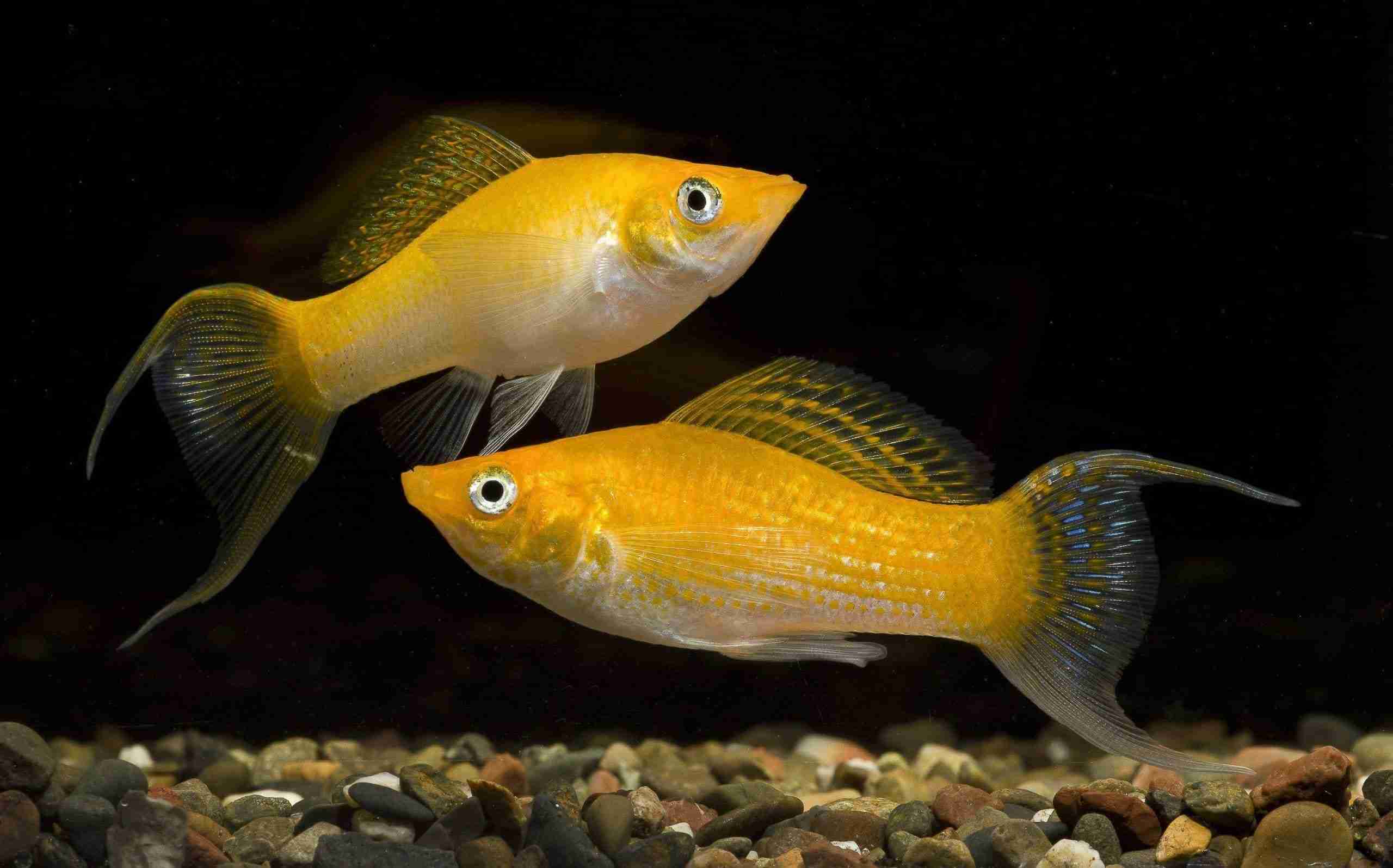One of the interesting ornamental fish with unique shapes and colors is the Molly fish. This fish, which has the Latin name Poecilia Sp, is not too big. You can keep it in a small aquarium.
You also don’t need to worry about keeping it together with other ornamental aquarium fish because molly fish is unaggressive. This type of fish comes from the continent of Central America and South America.
| Category | Rating |
| Scientific Name: | Poecilia sphenops |
| Common Names: | Molly, molly fish |
| Care Level: | Easy (Beginner Friendly) |
| Temperament: | Calm and peaceful |
| Size: | Up to 4.5 inches (11-12 cm) |
| Color: | Wide variety of colors |
| Life Expectancy: | Up to 5 years |
| Diet: | Omnivore |
| Family: | Poeciliidae |
| Minimum Tank Size: | 10 Gallons |
| Tank Setup: | Planted tank |
Table of Contents
Getting to Know the Beautiful Molly Fish
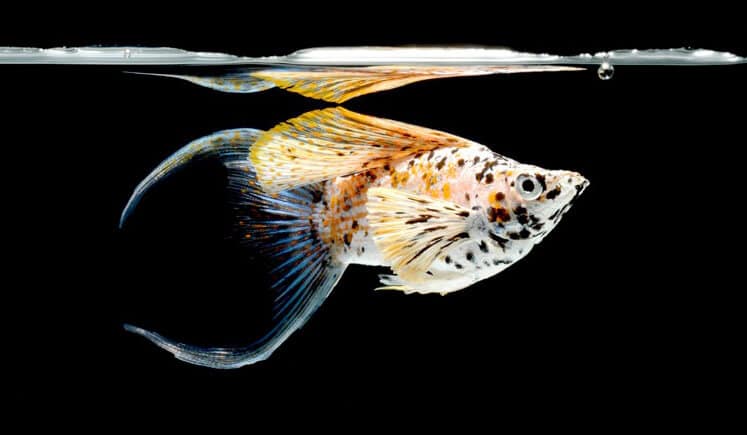
Long before molly gets popular among the aquarists, this fish was primarily only just for consumption in Mexico. Its beautiful physical shape with a pattern on each side of the body makes this magnificent fish used as a pet in your aquarium tank.
Appearance
Molly fish size only reaches up to 11-12 cm (4.5 inches) on fully grown. The body size of the female is a little bit bigger than the male. At first glance male and female molly fish look similar. But if you pay attention, their body parts are different according to their respective functions.
The female molly fish will later store the molly fish pups in her stomach. In male molly, the fins that are on top of the head are larger than in females. Its function to attract the attention of females.
Behavior
This fish is unaggressive, so it can adapt to other ornamental fish. This also very easy fish care does not require special care. Molly fish are a type of schooling fish. So you have to keep at least 4 fish in one aquarium to make them feel comfortable.
Although you rarely see this fish being aggressive, male fish sometimes harass the female fish, especially when they are about to breed.
Therefore, make sure the number of female fish is more than male.
10 Common Types of Molly Fish
It is difficult to distinguish the types of mollies because they have quite many features on each individual. But in general, this fish consists of 3 types. Starting from the Short-fin Molly (shortfin), Sailfin or Longfin Molly, and Lyretail Molly (forked tail).
Each group will usually also have several different types of fish. Also, now many people cross-breed and genetic mutations between one molly and another. This aims to get different results from the existing types of Molly fish.
1. Black Molly
This Molly has black scales all over its body to the tail and fins. If you want to keep them in an aquarium as ornamental fish, you should choose a proper tank that fits the black molly personality.
2. Dalmatian Molly
Having the same features as the Dalmatian dog, this fish is the top favorite balloon fish. This type of molly is a little different and special. They can grow slightly larger than the common black mollies, averaging a little under 5 inches. The more black and white, the more beautiful it is to look.
3. Black Sailfin Molly
The Sailfin Molly has long, beautiful fins. At first glance, it looks like an ornamental betta fish. This type of balloon fish is also easy to breed and maintain.
4. Wild Green Sailfin Molly
This type of fish is long-finned molly included in the Sailfin Molly group. This species is quite interesting because it is rare and highly valued. As the name, this fish has a greenish-gray base color with an orange color.
5. Yucatan Molly
The Yucatan Molly is also classified in the Sailfin Molly. Yucatan molly mostly has a red color with a little white on the stomach. This fish looks beautiful because of its muscular fins. His body size is also not too big. It can only grow up to 12 centimeters (cm).
6. Poecilia Latipinna Molly
This type of sailfin molly fish has a unique body pattern with spots and a rather wide dorsal fin. Even though it has a maximum size of only 12 cm, the female can have a larger body size than the male.
7. Silver Sailfin Molly
This fish is the result of the Poecilia hybrid. The white or silver sailfin molly has silvery scales and beautiful long fins. Usually, the female grows bigger than the male. The males are more pretty with orange markings on their dorsal area and turquoise markings on their tail fins.
8. Golden Black Molly
Golden black molly has a distinctive body characteristic. Its gold color covering its body from head to stomach and the partly black. This combination makes collectors hunt them too much.
9. Balloon Molly
With its body shape that resembles a balloon, it makes this type quite popular. Of course, you have seen this type of molly fish in various places.
10. Lyretail Molly
Unlike the sailfin, the lyretail molly has a characteristic tail in a variety of colors. Its tail looks like a ribbon at the top and bottom. The average striped color combine with beautiful colors.
Lifespan
Molly fish have a long life span, ranging from three to five years. This fish is strong enough against the disease. But poor water conditions will shorten the life expectancy of this species.
Some Molly fish species are also susceptible to disease, so you should know more details about your molly fish.
Molly Fish Care Guide
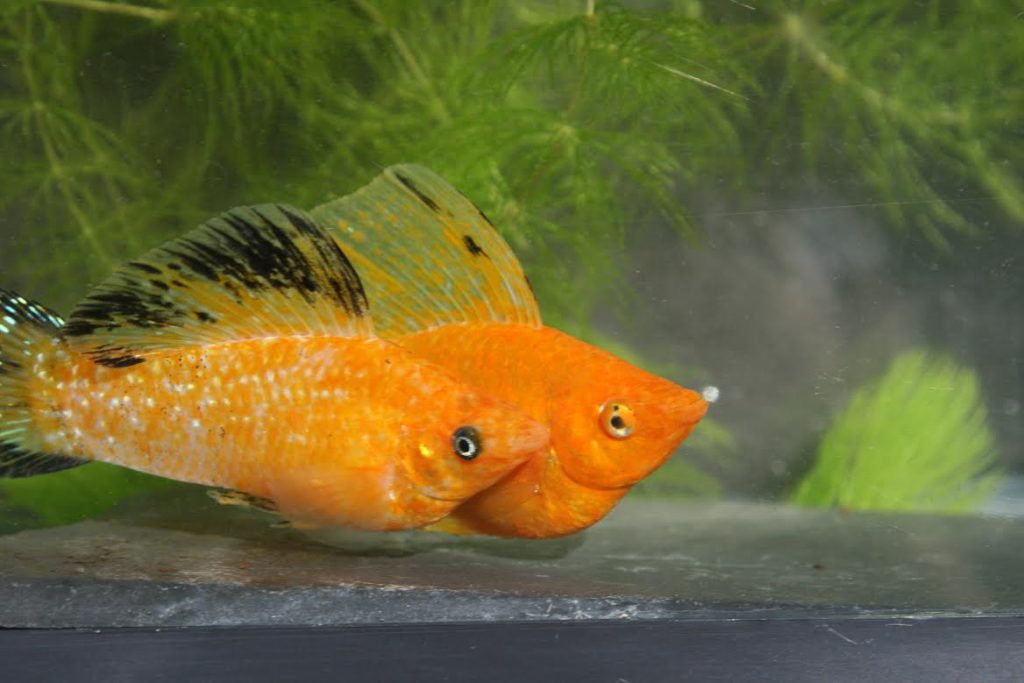
Caring for Molly fish is very easy and can be done by everyone. As long as you follow the proper care procedures, your molly fish will always be with you.
Habitat and Tank Requirement
Wild mollies live in various habitats and water conditions. This kind of fish even well adapted to brackish water and an environment with high hydrogen sulfide content.
Molly doesn’t need many spaces to live in. You only need a 10-gallon aquarium for at least four tiny mollies. However, sailfin molly specifically requires a bigger tank, so they don’t get stressed.
Speaking about aquatic plants for your mollies, this species has broad plants to choose from in order to support their quality of life. But, our recommendation to mimics the tropical rivers and streams as they came from.
Water Condition
As we mention above that mollies can live in such harsh water conditions, but we always prefer to put your fish in pure freshwater environments. Even though they are very adaptable, still, they prefer warm and neutral PH levels.
The water temperature required for these fish between 72 ° F to 78 ° F. A sufficient PH level for these tiny fish is 6.8 to 8.5. Meanwhile, the water hardness needed is around 20 to 30 KH. You should look for the best water test kit. So you can make tank adjustments to your favorite type of molly fish.
Diet and Feeding
Mollies are plant-based food eaters. This fish also likes algae that stick to rocks, wood, and sometimes they eat small invertebrates as well.
They also like vegetables like spinach. Besides, this will eat bloodworms, both frozen and live. Feeding them lives food is good for their growth. However, the best food for them is dry commercial pellets. Choose the highest quality for your beloved molly fish.
Tank Mates
Molly can live together with other fish because these species are calm and friendly enough. As long as the tank mate is unaggressive, the mollies will feel comfortable with them. Make sure you choose fish that are as small as the molly fish. Big fish will be aggressive and may eat your molly.
How To Breed Molly
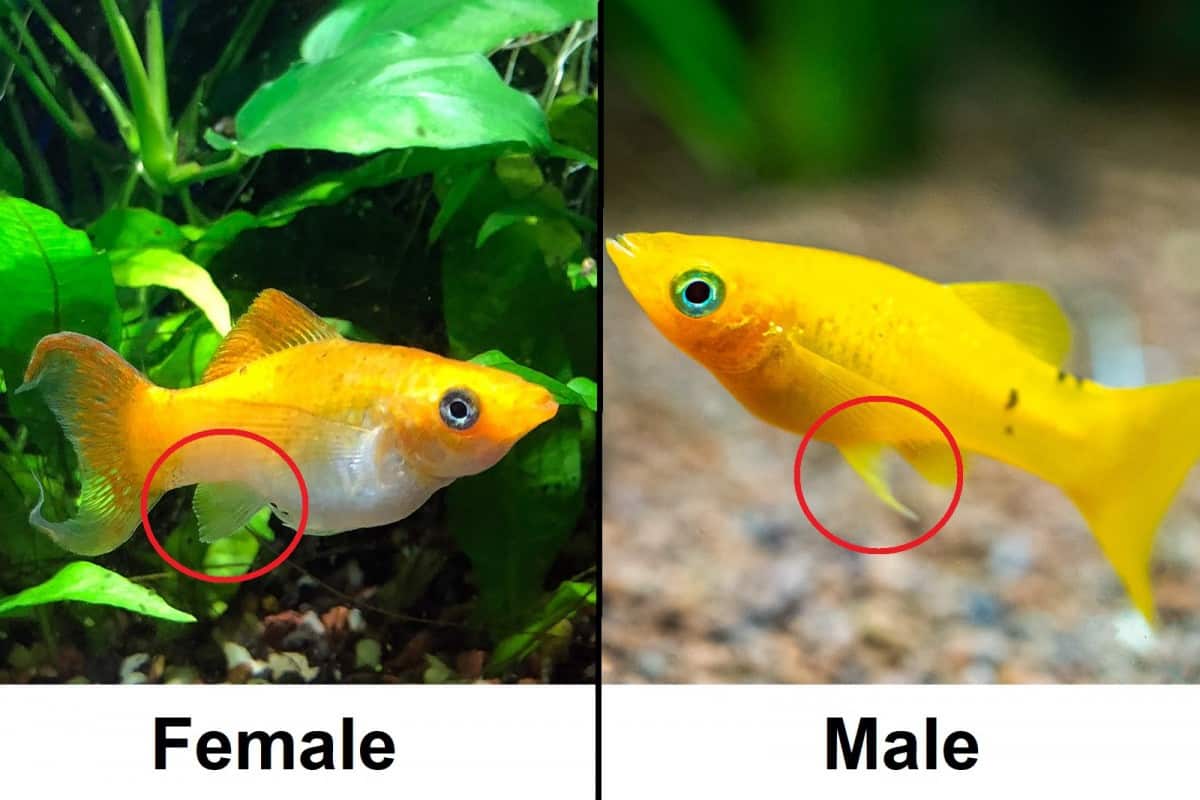
Mollies are sexually mature at a very early age. Reproductive age varies from each type of species. But the average male molly becomes productive at around 12 months of age and 6 months of age for female.
Molly reproduces using an internal fertilization procedure. After mating, eggs stored and developed inside the female body.
Eggs remain inside the female belly until the eggs hatched and ready to drop. The mating season for molly usually lasts about 3 to 6 weeks (20 to 40 days).
Once females release the babies, the next step you have to do is separate the adults to prevent young fry get eaten. It’s also important to breed molly in the breeding tank to increase the survival rate of the young.
Pregnancy
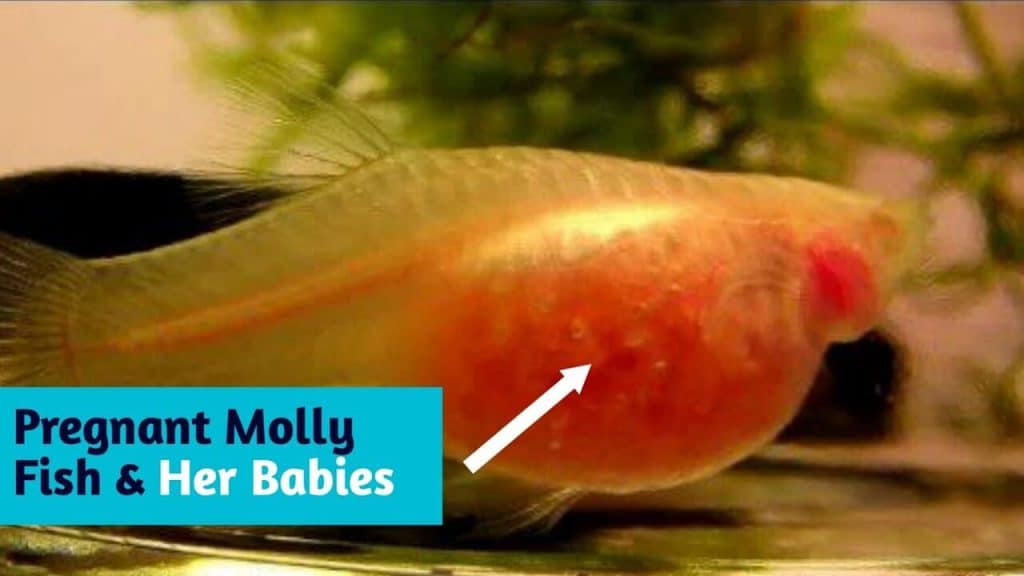
The gestation period for molly fish is about 60 days (8 weeks). Female molly can store sperm that is ejaculated by male molly during mating for up to several months. Female mollies can often fertilize eggs every 30 days even in the absence of male molly in the tank.
Molly usually doesn’t need any special care during their pregnancy. Provide the darker and quieter shelter to them for your pregnant molly hiding. Leave a dark room comfortable enough for them.
If these conditions are unavailable in your tank, then you should keep them in a separate aquarium with a hiding place or place the tank in the dark. Pregnant Molly also feels more relaxed in warm water than in normal tank temperatures.
Eggs and Babies
Many fish can lay up to thousands of eggs at a time. ‘Fecundity’ is a term used to define a fish’s capacity to lay eggs. Fecundity is different for each type of fish.
Fish that release their eggs in open water and don’t care about their eggs have very high fecundity. While fish that have to build nests to guard their eggs cannot lay as many eggs at one time, they have low fecundity.
Molly doesn’t lay eggs; they gave birth to baby molly. The fertilization process of an egg takes place in the belly of the female molly. After babies’ formation is complete, they come out of their eggs. Then the mother will give birth to them.
This way, the molly usually doesn’t have to look after their eggs. The fry is like a small version of the adult molly that can eat and care for themselves.
Molly Fish Diseases
Moly fish are identified for their good health and adaptability. However, this does not mean moly fish will always be healthy. Most common health issues found in mollies caused by parasite infections.
The following is a list of health problems causing by parasites and how to get rid of them:
White Spot
The cause of this disease is a parasite called Ichthyophthirius multifiliis. This disease will attack fish skin. It will cause white spots on the dorsal fin and tail of the fish.
Their black color makes this disease more pronounced in bright molly fish. To manage this disease by soaking the moly fish in 25% NaCl solution for 10 to 15 minutes.
Skin and Gill Flukes
Flukes on the skin and gill of mollies caused by a protozoan infection called Gyrodactylus Sp. This microscopic creature will eat the scales of the Molly fish until it bleeds. A small wound in skin tissue leads fungi to grow there. To treat this, you can use formaldehyde or betel leaf.
Saprolegnia
Saprolegnia is a disease caused by a fungus. Typically, the fungus can be present on the Molly fish’s body when the fish is injured. Fish infected with fungus will rub against the surrounding objects.
The malachite green is quite effective in treating fungus in molly fish. Additionally, betel leaf can remain an alternative treatment for this disease.
Lernaea Parasite
Worms can be a fatal disease in molly fish. This worm will attack the meat of your fish. Your beloved Molly fish will suddenly look thin and bleeding. To treat it, you can soak the molly fish in a 20% NaCl solution for 15 minutes.
Fish Lice
Molly fish disease is caused by fleas that enter the fish’s body to suck its blood. Then, the lice lay eggs in the fish’s body. Add table salt as much as 10 – 50 grams per liter would help a lot to kill these parasites in your aquarium tank.
Are You Interested in Molly Fish? (Summary)
Based on the explanation above, is it enough for you to believe that raising molly’s fish is not that difficult? With a long life span, you don’t have to worry about these tiny fish will quickly leave you.
Besides, you can make this fish your business. That is because molly fish is a unique freshwater aquarium fish and has a variety of beautiful colors. The high selling price makes its cultivation quite promising.

